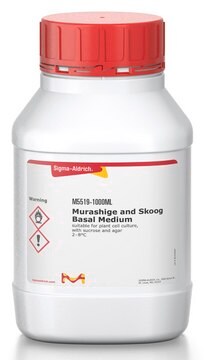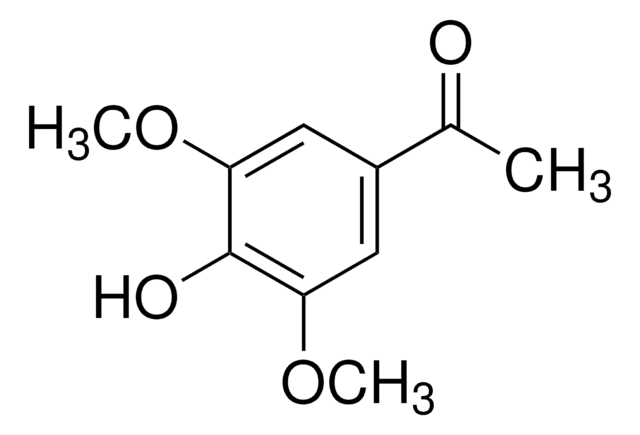H9773
Hygromycin B aus Streptomyces hygroscopicus
lyophilized powder, suitable for plant cell culture, BioReagent
Synonym(e):
Hygromycin
About This Item
Empfohlene Produkte
product name
Hygromycin B aus Streptomyces hygroscopicus, suitable for plant cell culture, BioReagent, ≥60% (HPLC), lyophilized powder
Biologische Quelle
Streptomyces hygroscopicus
Qualitätsniveau
Produktlinie
BioReagent
Form
lyophilized powder
Aufgereinigt durch
ion-exchange chromatography
Konzentration
≥60% (HPLC)
Methode(n)
cell culture | plant: suitable
Farbe
faintly brown to brown
white to beige
(1) 7.1, (2) 8.8
Löslichkeit
H2O: soluble 50 mg/mL
ethanol: soluble
methanol: soluble
Wirkungsspektrum von Antibiotika
fungi
Anwendung(en)
agriculture
Wirkungsweise
protein synthesis | interferes
Lagertemp.
2-8°C
SMILES String
CN[C@H]1C[C@@H](N)[C@H](O)[C@@H](O[C@@H]2O[C@H](CO)[C@H](O)[C@@H]3O[C@]4(O[C@H]([C@H](N)CO)[C@H](O)[C@H](O)[C@H]4O)O[C@H]23)[C@@H]1O
InChI
1S/C20H37N3O13/c1-23-7-2-5(21)9(26)15(10(7)27)33-19-17-16(11(28)8(4-25)32-19)35-20(36-17)18(31)13(30)12(29)14(34-20)6(22)3-24/h5-19,23-31H,2-4,21-22H2,1H3/t5-,6-,7+,8-,9+,10-,11+,12-,13+,14-,15-,16+,17+,18-,19+,20+/m1/s1
InChIKey
GRRNUXAQVGOGFE-XKIAHZFYSA-N
Suchen Sie nach ähnlichen Produkten? Aufrufen Leitfaden zum Produktvergleich
Allgemeine Beschreibung
Anwendung
Hygromycin B from Streptomyces hygroscopicus is used for gene cloning and ectopic expression. It is also used in MS medium for the in vitro screening of transgenic plants.
Biochem./physiol. Wirkung
Antimikrobielles Spektrum: Hygromycin B wirkt gegen Bakterien, Pilze und höhere eukaryotische Zellen.
Vorsicht
Angaben zur Herstellung
Signalwort
Danger
H-Sätze
Gefahreneinstufungen
Acute Tox. 1 Inhalation - Acute Tox. 2 Dermal - Acute Tox. 2 Oral
Lagerklassenschlüssel
6.1A - Combustible acute toxic Cat. 1 and 2 / very toxic hazardous materials
WGK
WGK 3
Flammpunkt (°F)
Not applicable
Flammpunkt (°C)
Not applicable
Analysenzertifikate (COA)
Suchen Sie nach Analysenzertifikate (COA), indem Sie die Lot-/Chargennummer des Produkts eingeben. Lot- und Chargennummern sind auf dem Produktetikett hinter den Wörtern ‘Lot’ oder ‘Batch’ (Lot oder Charge) zu finden.
Besitzen Sie dieses Produkt bereits?
In der Dokumentenbibliothek finden Sie die Dokumentation zu den Produkten, die Sie kürzlich erworben haben.
Kunden haben sich ebenfalls angesehen
Artikel
Protein synthesis is a complex, multi-step process involving many enzymes as well as conformational alignment. However, the majority of antibiotics that block bacterial protein synthesis interfere with the processes at the 30S subunit or 50S subunit of the 70S bacterial ribosome.
Antibiotic kill curve is a dose response experiment in which mammalian cells are subjected to increasing amounts of selection antibiotic
Unser Team von Wissenschaftlern verfügt über Erfahrung in allen Forschungsbereichen einschließlich Life Science, Materialwissenschaften, chemischer Synthese, Chromatographie, Analytik und vielen mehr..
Setzen Sie sich mit dem technischen Dienst in Verbindung.









